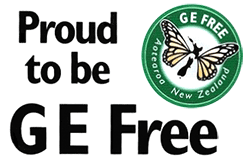Anger against the �deafness� and �conflict of interest� of GE food regulators has prompted actions in cities around New Zealand [1] and 276 cities around the World [2] to highlight the dangers that the GE plants pose to all sectors of the population.
There are 68 varieties of GE foods approved for the food chain expressing one or more (stacked) herbicide resistant or insecticide producing traits. Unless stated as non-GE or Organic, around 70% of processed foods contain GE derived ingredients mainly in the form of soy, corn, canola, cotton seed or vegetable oils, high fructose corn syrup, soy isolates, soy lecithin of which high levels are used in breads and cakes.
GE Free NZ concerns are two fold, one is the rising level of pesticides used on GE food crops and the other is the high level of insecticidal toxins produced by these foods, all of which have little or no scientific evidence of safety. After seventeen years of commercial growing the US has seen herbicide use rise to tens of millions kgs over non-GE crops mainly to combat weed and insect resistance.
This has prompted Dow Agrichemicals to develop their 2,4-D herbicide resistant plants. They reason that the only way to combat the management of hard to control RoundUp (RR) resistant weeds is with their 2,4-D resistant GE plants. Resistant weeds have infested farmland in twenty-five US states with a 50% increase of RR resistant weeds in 2012.Agent Orange formulation was 45% 2,4-D which is a highly toxic herbicide with links to cancers and reproductive disorders. It is banned in some European countries.
The US Department of Agriculture (USDA),[3] the regulatory organisation that approves GE crops for release to the environment last week postponed the expected approval of 2,4-D corn and soy until 2015 saying that there is not enough data to show that these crops are safe and any regulatory decisions may �significantly affect the quality of the human environment�.
Yet, the Food Safety Ministers of Australia and New Zealand on the advise of Food Standards Australia New Zealand (FSANZ) [4] have approved these non-existent corn and soybeans resistant to three herbicides (2,4-D, Glyphosate, Glufosinate).
�This is extraordinary as Dow has not given the regulators enough data on the environmental effects of the plants resistant to their 2,4-D formula, yet our Food Safety Ministers and FSANZ, have given the green light for them to enter the food chain in the total absence of any risk data as to their effects when eaten!� said Claire Bleakley, president of GE Free NZ.
In the last month, the European Food Safety Authority declined a GE corn application (A1020) for the food chain due to lack of safety information. [5] FSANZ approved this corn for the NZ food chain two years ago,
The Journal of Haematology and Thromboembolic Diseases has shown that mice fed, GE Bt insecticidal endotoxins (Cry) to kill insect pests, showed hematotoxic effects in red blood cells after one week. The findings, which also included depressed white blood cell counts and a reduction in the production of bone marrow cells are significant and should not be ignored. [6]
A French food safety research team, led by Professor Eric Seralini, conducted the first lifetime rat feeding study on a line of GE corn (NK603 corn) that had been approved 7 years ago by FSANZ. This corn was found to cause serious liver and kidney damage in rats. It also caused endocrine disruption and led to a significant increase in tumours in animals of both sexes. The results of this study were dismissed by FSANZ. [7]
�This shows that our Food Standards Authorities either do not have the expertise to evaluate GE food safety or they are withholding vital safety information as commercially sensitive from their colleagues, in which case they should provide the science that they used to approve this food� said Claire Bleakley
�We believe that FSANZ assessors have been unduly influenced by Industry opinions instead of human safety obligations and are in direct breach of their mandate to protect public health�.
We ask that people read labels and avoid foods that contain suspected GE ingredients. All food that is Organically certified are guaranteed GE Free and all food grown in New Zealand is GE free. New Zealand is a GE Free Nation in its commercial environment.
ENDS:
Claire Bleakley 06 3089842 / 027 348 6731
Elvira Dommisse: 03 9422 748/ 021 0575 123
References:
[1] Wellington March http://www.facebook.com/events/589013124456893/?fref=ts
[2] March Against Monsanto https://docs.google.com/spreadsheet
/lv?key=0Ah7h2ApbBPnpdGhOMElaSVg1QUQtRlJQWm1FaUZISlE&toomany=true
[3] USDA press release http://www.aphis.usda.gov/newsroom/2013/05/brs_24d_and_dicamba.shtml
[4] FSANZ Fellows http://www.foodstandards.govt.nz/scienceandeducation/scienceinfsanz/fsanzfellows.cfm
[5] Inadequate data prevent EFSA from concluding on safety of GM maize 98140 http://www.efsa.europa.eu/en/press/news/130416.
[6] Mezzomo BP, Miranda-Vilela AL, Freire IdS, Barbosa LCP, Portilho FA, (2013) Hematotoxicity of Bacillus thuringiensis as Spore-crystal Strains Cry1Aa, Cry1Ab, Cry1Ac or Cry2Aa in Swiss Albino Mice. J Hematol Thromb Dis 1:104. doi: 10.4172/jhtd.1000104
[7] Seralini. G-E., Clair. E., Mesnage. R., Gress. S., Defarge. N., Malatesta. M,. Hennequin. D. and de Vendomois. JS. (2012) Long term toxicity of a Roundup herbicide and Roundup-tolerant genetically modified maize. Food and Chemical Toxicity. Vol: 50, (11) 4221�4231http://dx.doi.org/10.1016/j.fct.2012.08.005
|


